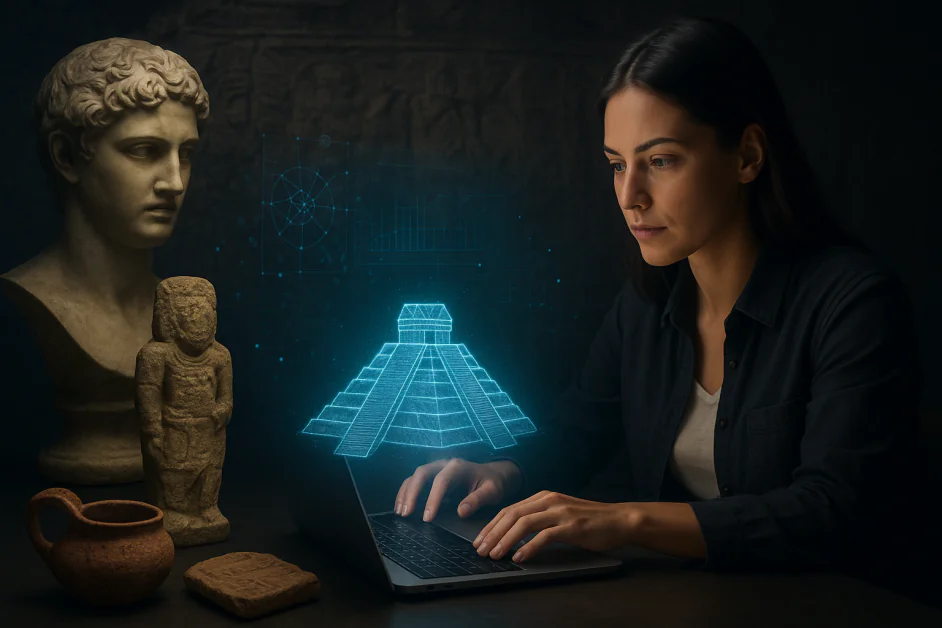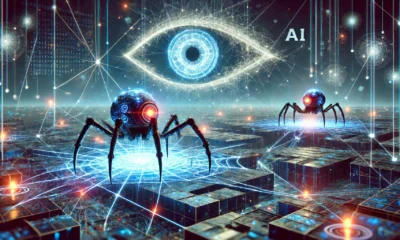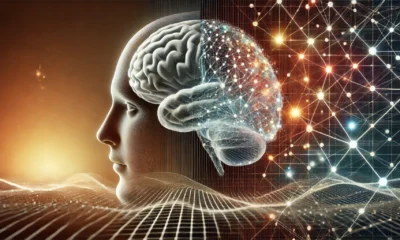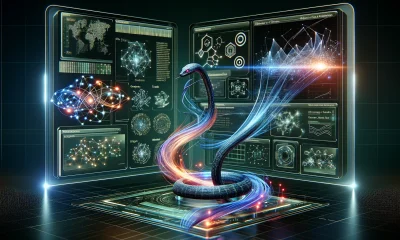Artificial Intelligence
AI as Time Traveler: Predicting Ancient Futures with Forgotten Data

Artificial Intelligence (AI) can be seen as a kind of time traveler. It cannot carry people through centuries, but it can move through the data left behind. From old texts to forgotten places, AI can study the traces of the past and show patterns that people might miss.
AI is becoming a new kind of explorer for history. By moving through data instead of time, it uncovers patterns the human eye may never see. Algorithms can restore damaged texts, decode lost languages, or scan satellite images to rediscover ancient cities buried under deserts and forests. In doing so, AI helps us imagine how people once lived, adapted, and even planned for their futures.
This makes AI feel like a different kind of time traveler. It connects the past with the present and points to futures that never happened. By uncovering hidden knowledge, it helps not only historians and scientists but also anyone trying to think about where humanity is going. Studying the remains of the past is not about nostalgia. It is about learning lessons, finding patterns, and gaining ideas that can guide the future.
What Does “AI as Time Traveler” Mean?
The idea of AI as a time traveler refers to the ability of AI to examine information from the past as if moving through time. While it does not literally cross centuries, AI works like a digital researcher that brings forward details hidden in past. It can study ancient texts, artifacts, trade records, climate patterns, and forgotten archives. Through this process, AI identifies links and patterns that may not be visible to human researchers.
For instance, AI could relate trade routes to weather changes to show how societies responded to environmental changes. Such analysis provides clearer pictures of historical events and daily life. AI can also go further by creating possible what-if scenarios. These reconstructions explore paths history might have taken if certain knowledge had survived or different choices had been made.
In this sense, AI does more than examining the past. It allows us to imagine unrealized futures that past civilizations never achieved. By doing so, it deepens our understanding of human history and expands the ways we can think about its outcomes.
The Role of AI in Uncovering Forgotten Data
Much of human history has been lost over time. Wars, natural disasters, and decay destroyed countless records. Oral traditions disappeared before they were ever written down. Many ancient languages remain undeciphered. These gaps in our knowledge are what scholars call forgotten data.
AI brings new ways to recover meaning from this fragmented past. Unlike traditional methods, which often require complete records, AI can work with partial, scattered, and noisy information. By combining different sources, it uncovers patterns and connections that would otherwise remain hidden.
Several AI techniques play an important role in this process:
- Natural Language Processing (NLP): Modern language models can read damaged or incomplete texts. They recognize scripts, translate contextually, and even reconstruct missing sections of manuscripts.
- Computer Vision: Image-recognition algorithms can analyze photographs of artifacts, ruins, and old manuscripts. They have the ability to detect fine details such as faded markings or subtle textures that the human eye might miss.
- Machine Learning and Pattern Recognition: AI uses clustering and classification methods to link scattered pieces of evidence. For example, it can group broken pottery shards by style or origin, even when no single piece is whole.
- Data Integration and Fusion: AI can merge satellite images, field surveys, archives, and sensor data into unified models, providing a richer picture of historical and environmental contexts.
Additional tools such as neural translation systems and image enhancement improve the quality of damaged records. Probabilistic models allow AI to handle uncertainty and missing information, making its conclusions more reliable.
These advances are growing quickly. In 2024, the United States led global AI investment with $109.1 billion, nearly 12 times China’s $9.3 billion and 24 times the U.K.’s $4.5 billion, according to the Stanford AI Index Report 2025. These investments are leading to applications that are reshaping historical and environmental research.
In archaeology, machine learning is applied to satellite imagery and LiDAR scans to identify undiscovered sites, achieving up to 80% accuracy in areas such as Mesopotamia. Generative models are also used to reconstruct lost cultures and simulate ancient economies from incomplete data.
Beyond history, AI-assisted analysis of paleoclimate records such as ice cores and sediment layers helps refine long-term climate models. Projects like LinkedEarth and NOAA-supported initiatives use these datasets to improve understanding of past climate cycles and support more informed forecasting.
Taken together, these developments position AI as a digital archaeologist. It not only preserves the past but also recovers long-hidden knowledge, supporting historical understanding and sustainable innovation.
AI as a Tool for Reconstructing Possible Histories
Beyond recovering fragments of the past, AI is now used to model how history might have unfolded under different conditions. Instead of treating the past as fixed, researchers use algorithms to test dynamic possibilities, where incomplete records become starting points for building alternate scenarios. These applications often take the form of temporal modeling, probabilistic simulation, and multi-modal integration, each offering a way to examine how past events may have unfolded differently.
Temporal Modeling
Specialized algorithms such as Long Short-Term Memory (LSTM) networks and transformers analyze time-dependent records. Even when data is sparse, they help identify cause–effect patterns, for example, between environmental stress and social change or between economic activity and migration.
Probabilistic Simulation
Bayesian networks, Monte Carlo methods, and generative models allow researchers to test what-if scenarios. These tools simulate alternative outcomes, such as how variations in rainfall, resource distribution, or conflict might have reshaped the stability of ancient civilizations.
Multi-Modal Integration
Graph-based models and attention mechanisms combine information from maps, inscriptions, artifacts, and climate datasets into unified simulations. This enables not just reconstruction of lost events but also exploration of multiple possible futures grounded in available evidence.
Research Ecosystem
These advances are supported by modern AI frameworks such as TensorFlow and PyTorch, large-scale data platforms like Apache Spark, and increasingly autonomous agentic AI systems that can process incomplete datasets with minimal supervision. Low-code tools now allow archaeologists and historians to design predictive experiments without extensive technical expertise.
Through these methods, AI does not simply fill gaps in history. It provides a structured way to explore how events might have diverged, offering researchers new perspectives on the resilience, fragility, and adaptability of past societies.
Real-World Examples
AI is now helping researchers uncover and reconstruct history in ways that were not possible before. In South America, a major breakthrough came when LiDAR technology revealed over 60,000 hidden Mayan structures beneath dense forest cover in northern Guatemala, including pyramids, roads, and homes. In later studies, AI has been used to analyze similar LiDAR datasets to assist in archaeological mapping.
AI is also being used to decode ancient scripts. For example, researchers are training models to analyze Linear A, an undeciphered writing system from Bronze Age Crete. These models compare unknown symbols with known languages to suggest possible meanings and linguistic structures.
Preservation efforts also benefit from AI. The RePAIR project, led by the University of Bonn, uses AI and robotics to reassemble broken frescoes and pottery at sites like Pompeii (RePAIR Project). Generative Adversarial Networks (GANs) have also been applied to restore damaged Roman coins and other artifacts, improving their visualization and helping with identification.
In education, universities are using AI to build 3D reconstructions of ancient sites. These models allow students to explore digital versions of cities and temples, enhancing learning through immersive experiences. Institutions like Virginia Tech and Purdue University have developed virtual environments for Egyptian tombs and Pre-Hispanic cities.
These examples show how AI is not only advancing discovery and preservation but also making the past more accessible for research, restoration, and education.
The Bottom Line
AI is becoming a powerful partner in understanding the past. It is helping archaeologists discover hidden sites, decode lost scripts, and preserve fragile artifacts with precision that was once impossible. Beyond preservation, it allows researchers to reconstruct ancient cultures, economies, and even climates, providing insights that connect history with present challenges.
These advances are not only academic. They also influence modern farming, environmental planning, and education, showing how old knowledge can transform future innovation. At the same time, the role of AI in history raises questions about accuracy, interpretation, and cultural responsibility. By treating AI as both a tool and a guide, scholars and societies can ensure that technology deepens our respect for history while offering lessons that remain vital for tomorrow.












